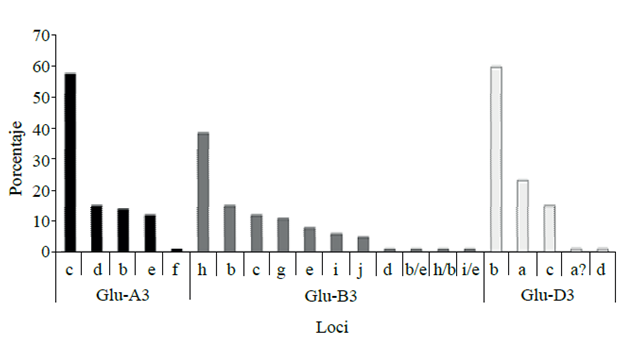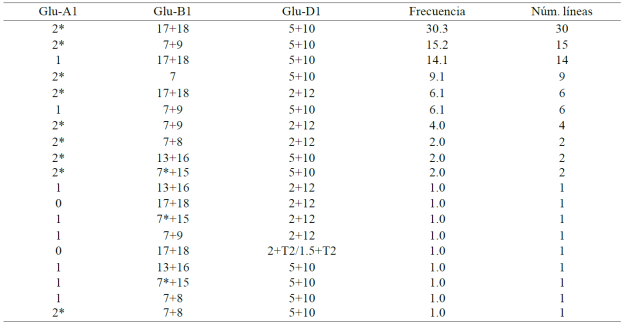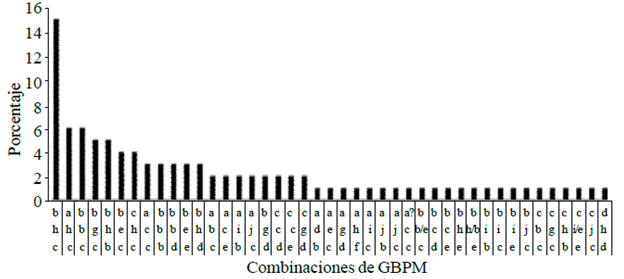Services on Demand
Journal
Article
Indicators
-
 Cited by SciELO
Cited by SciELO -
 Access statistics
Access statistics
Related links
-
 Similars in
SciELO
Similars in
SciELO
Share
Revista mexicana de ciencias agrícolas
Print version ISSN 2007-0934
Rev. Mex. Cienc. Agríc vol.5 spe 8 Texcoco 2014
Investigation notes
Allelic diversity of glutenins in rainfed bread wheat in Mexico
1Campo Experimental Valle de México-INIFAP. Carretera los Reyes-Texcoco, km 13.5. Caotlinchán, Texcoco. Edo de Méx. C. P. 56250. Tel. (595) 92 12657. (villaseñor.eduardo@inifap.gob.mx; hortelano.rene@inifap.gob.mx; perez.patricia@inifap.gob.mx; rodríguez.maria@inifap.gob.mx; espitia.eduardo@inifap.gob.mx).
2Centro Internacional de Mejoramiento de Maíz y Trigo. Carretera México-Veracruz, El Batán, km 45, Texcoco, Edo de Méx. C. P. 56130. Tel. (595) 9521900. (j.pena@cgiar.org.mx).
The parent group from the rainfed wheat program in Mexico was characterized based on their high (HMW-G) and low (LMW-G) molecular weight glutenin variants. The HMW-G and LMW-G were identified by polyacrylamide gel electrophoresis. Frequencies were calculated for the Glu-A1, Glu-B1, Glu-D1, Glu-A3, Glu-B3 and Glu-D3 loci as well as for their HMW-G and LMW-G combinations. Greater polymorphism was observed in the Glu-B1 and Glu-B3 loci with 6 and 8 individual variants respectively. HMW-G alleles with higher frequency were 2 in Glu-A1, 17+18 in Glu-B1 and 5+10 in Glu-D1, and for LMW-G were the c variants in Glu-A3, h in Glu-B3 and b in Glu-D3. In the Glu-B1 and Glu-D1 loci two new alleles 7+15 and 2+T2/1.5+T2 were identified. Furthermore the HMW-G combination with higher proportion were 2, 17+18, 5+10 and for LMW-G c, h, b. Based on the above, there are alleles and HMW-G and LMW-G combinations in the parent group of rainfed bread wheat in Mexico, favoring progeny generation with suitable quality for the bakery, biscuit and pastry products preparation.
Keywords: characterization; high and low molecular weight glutenins; bread wheat
Se utilizó el grupo de progenitores del programa de trigo de temporal de México, con el objetivo de caracterizarlos con base en sus variantes de gluteninas de alto peso molecular (GAPM) y bajo peso molecular (GBPM). Las GAPM y GBPM Se identificaron mediante electroforesis en geles de poliacrilamida. Las frecuencias se calcularon para los loci Glu-A1, Glu-B1, Glu-D1, Glu-A3, Glu-B3 y Glu-D3 así como para sus combinaciones de GAPM y GBPM. Se observó mayor polimorfismo en los loci Glu-B1 y Glu-B3 con 6 y 8 variantes individuales, respectivamente. Los alelos de GAPM de mayor frecuencia fueron 2 en Glu-A1, 17+18 en Glu-B1 y 5+10 en Glu-D1, y para el caso de GBPM lo fueron las variantes c en Glu-A3, h en Glu-B3 y b en Glu-D3. En los loci Glu-B1 y Glu-D1 se identificaron dos nuevos alelos 7+15 y 2+T2/1.5+T2. Por otro lado la combinación de GAPM de mayor proporción fueron 2, 17+18, 5+10 y de GBPM c, h, b. Con base en lo anterior, en el grupo de progenitores de trigo harinero de temporal de México, existen alelos y combinaciones de GAPM y GBPM que favorecen la generación de progenies con calidad apta para la elaboración de productos de panificación, galletería y repostería.
Palabras clave: caracterización; gluteninas de alto y bajo peso molecular; trigo harinero
Overall 90.4% bread wheat production (Triticum aestivum L.) in Mexico is processed by the domestic milling industry, thus physical and chemical variables of grain quality must be met, as well as dough strength and extensibility (CANIMOLT, 2010). These last two variables are partially dependent on quantity and quality of the glutenin and gliadin proteins, present in the flour (Souza et al., 2013), which are encoded by the Glu-A1, Glu-A3, Gli-A1 y Gli-A2 loci (Payne and Lawrence, 1983). Since glutenins and gliadins are under genetic control, they can be manipulated and recombined through plant breeding.
Several national (Martínez-Cruz et al., 2010b) and international (Liang et al., 2010) studies indicate the effect of HMW-G, LMW-G and gliadins on dough strength and extensibility. A prerequisite in breeding programs is knowledge about the germplasm used in crosses to generate variability for the desired trait. In Mexico, developing an improved bread wheat variety require the combination of high yield potential, drought tolerance, disease resistance (yellow and leaf rust) and specific industrial quality (bread and biscuits preparation). Therefore this research aimed to identify the HMW-G and LMW-G alleles in the parent group genotypes from the rainfed bread wheat program of the National Institute for Forestry, Agriculture and Livestock (INIFAP).
Overall 99 genotypes from the parent group in the INIFAP rainfed wheat program were used. The materials were established during the spring-summer season 2011 in Chapingo, Mexico. The experimental plot consisted of four rows, 3 m long with a 30 cm spacing among them. Electrophoretic analysis was performed on 40 mg of flour, obtained from an UDY cyclone mill with a 0.5 mm mesh, grinding grains from one spike per plot. The electrophoretic method used was described by Peña et al. (2004), using polyacrylamide gels in basic pH conditions and sodium dodecyl sulfate as denaturing agent. The HMW-Gs were identified by the nomenclature proposed by Payne and Lawrence (1983) and the LMW-Gs at Glu-A3 and Glu-B3 were designated according to Singh et al.(1991) and Jackson et al. (1996), while Glu-D3 alleles were named according to Branlard et al. (2003). Allele frequencies were calculated for the Glu-A1, Glu-B1, Glu-D1, Glu-A3, Glu-B3 and Glu-D3 loci as well as for the HMW-G and LMW-G combinations.
The highest HMW-G polymorphism was observed in the Glu-B1 locus, while Glu-A1 and Glu-D1 loci had lower and equal number of allelic variants. The most frequent allele were: 2* in Glu-A1, 17+18 in Glu-B1 and 5+10 in Glu-D1, with 71.1, 52.5 and 82.8% respectively (Table 1). These frequencies are comparable to those reported by Liang et al. (2010) who evaluated 273 genotypes from the irrigation program of the International Maize and Wheat Improvement Center (CIMMYT). Less frequent variants were 0 in Glu-A1, 13+16, 7*+15 and 7+8 in Glu-B1 and 2+T2/1.5+T2 in Glu-D1. Importantly, the 7*+15 and 2+T2/1.5+T2 variants, had not been previously identified in the parent group, according to reports from Espitia et al. (2008) and Martínez-Cruz et al. (2010a) who analyzed them in the spring-summer 2001 and spring-summer 2008 cycles respectively.
Table 1 HMW-G allele frequency in the parent group from the INIFAP national rainfed bread wheat program. Chapingo spring-summer 2011.

For 2+T2/1.5+T2 a genotypic mixture of two alleles was found (separated by the slash), which comes from Triticum tauschii L. one of the wheat ancestors (Pilch, 2007). The Figure 1 shows the variants encoding LMW-G. Greater -polymorphism was observed at locus Glu-B3 where seven allelic variants and four allele mixtures were identified. Five loci were identified at each of the Glu-A3 and Glu-B3 loci. Thus, the c alleles in Glu-A3, h in Glu-B3 y b in Glu-D3, appeared in 57.6, 38.4 and 59.6% of the genotypes analyzed, respectively. Individual alleles of lowest frequency were f in Glu-A3, j in Glu-B3 as well as d in Glu-D3. The h allele in Glu-B3 was found at similar frequencies to genotypes evaluated by Liang et al. (2010), while the j variant associated with adverse effects on dough strength and extensibility (Martínez-Cruz et al., 2012) appeared at low frequency.

Figure 1 LMW-G allele frequency in the parent group from the INIFAP national rainfed bread wheat program. Chapingo spring-summer 2011.
The HMW-G 2*, 17+18, 5+10 combination was the most frequent (30.3%), followed by 2*, 7+9, 5+10 and 1, 17+18, 5+10 with 15.2% and 14.1% , respectively, while there were nine combinations that occurred in 1% (Table 2). For the LMW-G, the c, h, b combination showed the highest frequency, appearing in 15 genotypes, followed by c, h, b and c, b, b associated with 6 materials. Furthermore 23 combinations appeared with percentages equal to 1, Figure 2. In addition, the 2*, 17+18, 5+10 and c, h, b combinations, in higher proportion, showed alelles suitable for line development for bakery products consistent with reports from Martinez-Cruz et al. (2010b). But also the 2*, 17+18, 2+12 and c, g, b combinations could recombine to generate genotypes suitable for biscuits production.
Table 2 HMW-G combinations frequency in the parent group from the INIFAP national rainfed bread wheat program. Chapingo spring-summer 2011.


Figure 2 LMW-G combinations frequency in the parent group from the INIFAP national rainfed bread wheat program. Chapingo spring- summer 2011.
The parent group from the INIFAP rainfed bread wheat, contains allelic variants and several HMW-G and LMW-G combinations, from which progenies can be derived, with specific quality for bread, biscuit and pastry products preparation. Also two new alleles were identified, broadening the HMW-G genetic diversity at the Glu-B1 and Glu-D1 loci.
Literatura citada
Branlard, G.; Dardevet, M.; Amiour, N. and Igrejas, G. 2003. Allelic diversity of HMW and LMW glutenin subunits and omega-gliadins in French bread wheat (Triticum aestivum L.). Gen. Res. Crop Evol. 50:669-679. [ Links ]
Cámara Nacional de la Industria Molinera Nacional del Trigo (CANIMOLT). 2010. Reporte estadístico 2010. México, D. F. 94 pp. [ Links ]
Espitia, R. E.; Martínez, C. E.; Peña, B. R. J.; Villaseñor, M. H. E. y Huerta, E. J. 2008. Polimorfismo de gluteninas de alto peso molecular y su relación con trigos harineros para temporal. Agric. Téc. Méx. 34:57-67. [ Links ]
Jackson, E.A.; Morel, M. H.; Sontag-Strohm, T.; Branlard, G.; Metakovsky, E. V. and Redaelli, R. 1996. Proposal for combining the classification systems of alleles of Gli-1 and Glu-3 loci in bread wheat (Triticum aestivum L.). J. Genet. Breed. 50:321-336. [ Links ]
Liang, D.; Tang, J.; Peña, R. J.; Singh, R.; He, X.; Shen, X.; Yao, D.; Xia, X. and He, Z. 2010. Characterization of CIMMYT bread wheats for highland low-molecular weight glutenin subunits and other quality-related genes with SDS-PAGE, RP-HPLC and molecular markers. Euphytica 172:235-250. [ Links ]
Martínez-Cruz, E.; Espitia-Rangel, E.; Villaseñor-Mir, H. E.; Molina-Galán, J. D.; Benítez-Riquelme, l.; Santacruz-Varela, A. y Peña-Bautista, R. J. 2010a. Diversidad genética de gluteninas y gliadinas en trigos harineros (Triticum aestivum L.) mexicanos. Agrociencia 44:185-196. [ Links ]
Martínez-Cruz, E.; Espitia-Rangel, E.; Villaseñor-Mir, H. E.; Molina-Galán J. D.; Benítez-Riquelme, I.; Santacruz- Varela, A. y Peña-Bautista, R. J. 2010b. Diferencias reológicas de la masa de trigo en líneas recombinantes II. Relación con combinaciones de los loci Glu-1 y Glu-3. Agrociencia 44:631-641. [ Links ]
Martínez-Cruz, E.; Espitia-Rangel, E.; Villaseñor-Mir, H. E. y Peña-Bautista, R. J. 2012. Contribución de los loci Glu-B1, Glu-D1 y Glu-B3 a la calidad de la masa del trigo harinero. Rev. Fitotec. Mex. 35(2):135-142. [ Links ]
Payne, P. I. and Lawrence G. J. 1983. Catalogue of alleles for the complex loci Glu-A1, Glu-B1 and Glu-D1, which code for high-molecular-weight subunits of glutenin in hexaploid wheat. Cereal Res. Commun. 11:29-35. [ Links ]
Peña, R. J.; González, S. H. and Cervantes, F. 2004. Relationship between Glu-D1/GluB-3 allelic combinations and bread making quality-related parameters commonly used in wheat breeding. In: Lafiandra, D.; Masci, S. and D'Ovidio, R. (Eds.). The gluten proteins. RSC Publishing, Cambridge, UK. 156-157 pp. [ Links ]
Pilch, J. 2007. Improving grain quality in winter wheat (TriticumAestivum L.) by introgressing alien HMW glutenin genes from tetraploid Triticum and diploid Aegilops species: a review. Plant Breed. Seed Sci. 56:3-30. [ Links ]
Singh, N. K.; Shepherd, K. W.; and Cornish, G. B. 1991.Asimplified SDS-PAGE procedure for separating LMW subunits of glutenin. J. Cereal Sci. 14:203-208. [ Links ]
Souza, C. M.; dos Santos S. M. B. and Landi F. C. M. 2013. Effect of high and low molecular weight glutenin subunits, and subunits of gliadin on physicochemical parameters of different wheat genotypes. Ciénc. Tecnol. Aliment. 33(1):163-170. [ Links ]
Received: January 2014; Accepted: April 2014











 text in
text in 


